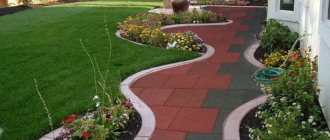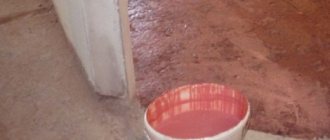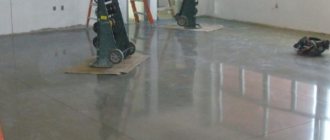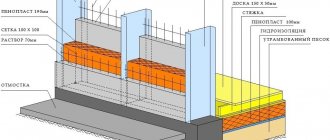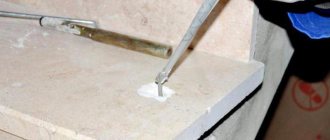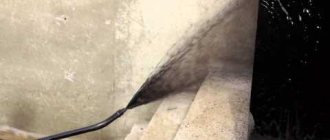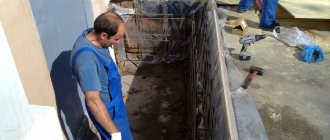Very often during the renovation process it becomes necessary to combine materials that seem completely incompatible. To an inexperienced master, such tasks may seem simply impossible, but there is a specialized substance that can help. For example, concrete contact applied to oil paint becomes an excellent basis for gluing wallpaper or covering walls with ceramic tiles.
Universal primer
Main technical characteristics
Floor application
This composition is a building material belonging to the class of primers. The product is used to turn a smooth surface into a rough one with excellent adhesive parameters.
The concrete contact structure includes the following components:
- Acrylic;
- Quartz sand;
- Durable adhesive composition.
The main technical characteristics of concrete contact allow it to have the following parameters:
- Once applied to a surface of this type, the primer dries very quickly. Repair work can begin after just a few hours;
- This type of coating is not susceptible to moisture. Also, a layer of this kind can easily be classified as a waterproofing material;
- Quite a long period of action. Manufacturers claim that the product can retain its waterproofing and adhesion functions for 80 years after application to the surface.
In order to determine which concrete contact is best, you should first familiarize yourself with the full list of technical characteristics of these products.
Application area
Coverage scheme
The main purpose of applying the composition to the surface is to increase the level of adhesion of materials that have low absorbency. Monolithic concrete, for example, is a surface that does not absorb moisture well, which makes it problematic to apply most building materials to such a base.
Therefore, in order to create a high-quality finish, you should first apply concrete contact to the base, and then plaster it.
This primer is a substance that can be used not only for interior finishing work. Its use is also justified in the production of facade finishing, as well as for application to wood or metal.
Note! Previously, in order to increase the adhesion properties of the surface, a bandage was used, but its application required dexterity and special skills from the master.
Concrete contact primer - properties and application
It is advisable to use this primer as an intermediate layer between a concrete or brick wall and subsequent finishing materials. Concrete contact primer has the ability to penetrate deeply into the surface of any material, change its properties and reliably hold various facing materials. The adhesion it increases is adhesion, the penetration of different materials into each other. This explains the excellent characteristics of this solution.
Concrete contact is indispensable before plastering walls, before laying tiles on a kitchen splashback, before installing a wet screed on a concrete base.
The adhesive properties of this solution allow it to be used as a primer for kitchen walls on surfaces painted with any paint, polystyrene foam, reinforced concrete and just concrete, old tiles and plasterboard sheets. Or on previously oiled surfaces. When applied to crumbling, loose surfaces, it significantly increases their strength and reliably prepares them for subsequent installation of facing materials. Laying tiles on a kitchen backsplash without leveling the wall is almost impossible without concrete contact. Improves the physical properties of lime, cement and gypsum plaster, and is used for puttying metal surfaces.
Related article: Type of kitchen countertops: choosing a kitchen countertop by material
Before laying the tiles, the wall is covered with Betonokontakt Betonokontakt on the kitchen wall under the tile apron
Release form
In the modern market, such building material is produced by a huge number of manufacturing companies.
But the classification of this primer is carried out depending on the form of release:
- Ready mixture is sold in buckets of 5 to 20 liters. The shelf life of such a primer is about a year at above-zero temperatures. If the mixture has been frozen, it loses its properties and becomes unusable;
In the photo - a bucket with the finished mixture
- The dry mixture is produced in bags of 3-5 kg. Such material is stored for about a year at above-zero temperatures. When opening the bag, you should be very careful and protect your respiratory tract from getting the mixture. Exact instructions for preparing concrete contact should be written on the container.
Surface application
Applying concrete contact yourself is a process that does not require the purchase of specialized tools and devices. The answer to the question of how to apply concrete contact can be either a regular brush or a paint roller.
Roller processing
The instructions, which stipulate how to apply concrete contact, consist of the following steps:
- Prepare the surface by clearing it of dust and dirt, as well as loose elements;
- Before using this product, the first thing you need to do is treat the concrete surface with a simple primer;
Advice. Applying primer will completely remove dust from the surface and ensure good connection between the top layer and the concrete contact.
- Wait for the concrete primer to dry completely;
- Next, apply the composition to the surface using a roller, spatula or an ordinary brush;
Advice. Make sure that the applied coating is smooth and uniform.
Coating
If the solution gets on a surface that you did not plan to treat, you should remove it as soon as possible. Soil should be removed using a damp rag. If the material is not removed in time, the primer will dry out and it will only be possible to remove it using mechanical surface treatment methods.
The drying time for concrete contact is several hours. Be careful because after 1 hour it may seem that the surface is dry, but if you begin to carry out further work, you can damage the created layer.
Advice. In order to determine whether the coating has dried, it is enough to run a metal spatula across the surface. If the coating peels off, the surface must be left until it dries.
The use of concrete contact is advisable only if further surface treatment will be carried out soon, since over time such a coating becomes covered with dust, which impairs adhesion.
Advice. If more than two days have passed after applying concrete contact to the surface, then you should first treat it with a primer and only then finish it.
Soil consumption
Different types of primers have different consumption
In order to correctly calculate the amount of this substance to cover the surface of the required area and find out what its price will be, you need to know the consumption of the product per 1 m2:
- For hard and highly porous surfaces (plaster, screed, concrete, brickwork) - soil is consumed in the amount of 300-500 ml per 1 m2;
Advice. If the base to be coated with this primer is highly porous, it should first be treated with non-chemical impregnations that penetrate deeply into the surface.
- If the surface has medium porosity (high-strength concrete monolith, vibrating concrete slab, self-leveling and self-leveling floors) - 200-350 ml of product per 1 m2 of surface;
- Low-porosity bases (tiles, oil paint, fiberboard, chipboard) - on average 150-250 ml per 1 m2.
How to save on soil
The cost of this building material is not so high that you should try to save money on its purchase. If you try to reduce the consumption of this product, the resulting coating may eventually lose its strength characteristics, partially crack, or even peel off.
Also, a decrease in consumption will lead to a decrease in the adhesive parameters of the coating and will reduce the resistance of the layer to moisture.
SovetRemont.com
In some cases, in the midst of renovations in your apartment, the need arises to lay new tiles directly on top of the old ones. For many, this raises a very logical question, which we will talk about today, namely, how to lay tiles on tiles so that the newly laid layer does not begin to fall off after a short period of time? To solve this problem, a special type of primer is usually used; I advise you to choose a primer called “Concrete Contact”.
As a rule, a new tile layer is laid directly on top of the old tile without prior removal for two reasons. The first is when removing the previous layer of tiles requires a lot of labor and time, if you have a large room, then if you reduce the height by a couple of centimeters you do not lose anything and save a lot of time. The second reason is that the deadlines allocated for the facing work are too short. In any case, the decision whether you will lay tiles on tiles depends entirely on you, since there are no building codes prohibiting this process.
Before applying a primer layer to the surface of the tile, you need to thoroughly clean its surface from all kinds of contaminants. You can apply the primer not only with a roller, but also with a brush. Before using the solution, you need to stir it thoroughly; while working, you also need to periodically stir the primer mixture. Make sure that it does not get into your eyes; if this does happen, rinse them with plenty of water as soon as possible. You should wear rubber gloves during the priming process. It is calculated that on average about 300 grams of mixture will be consumed per square meter.
Now a little about the above-mentioned concrete contact. This soil consists of sand, cement and special impurities, and is designed specifically for such situations. It can be used not only for treating tiled surfaces, but also for other poorly absorbent materials. When finished, you will have a rough, sandpaper-like surface. This product can be found in many construction-related stores; the main thing is to beware of counterfeits.
So let's get back to business. When you complete the priming work, you will have to wait until the surface is completely dry. This will take you no more than 3 hours. After this, you will get a surface that is very suitable for laying new tiles, which also does not have to be plastered, unless you need to get rid of certain irregularities.
At the end of my story, I want to advise you to protect all parts of the room that you do not intend to prime with plastic bags. Otherwise, the question of how to lay tiles on tiles will fade into the background compared to the problem of removing concrete contact from unwanted surfaces. If the solution gets somewhere and has time to set, you don’t even have to try to tear it off.
This is where I end and, as always, I wish you success in your renovation!
Author: Letyaga G.P.
I suggest watching a video on the topic. I'm sure you'll like it!
https://youtu.be/https://www.youtube.com/watch?v=G9F01cadZR4
